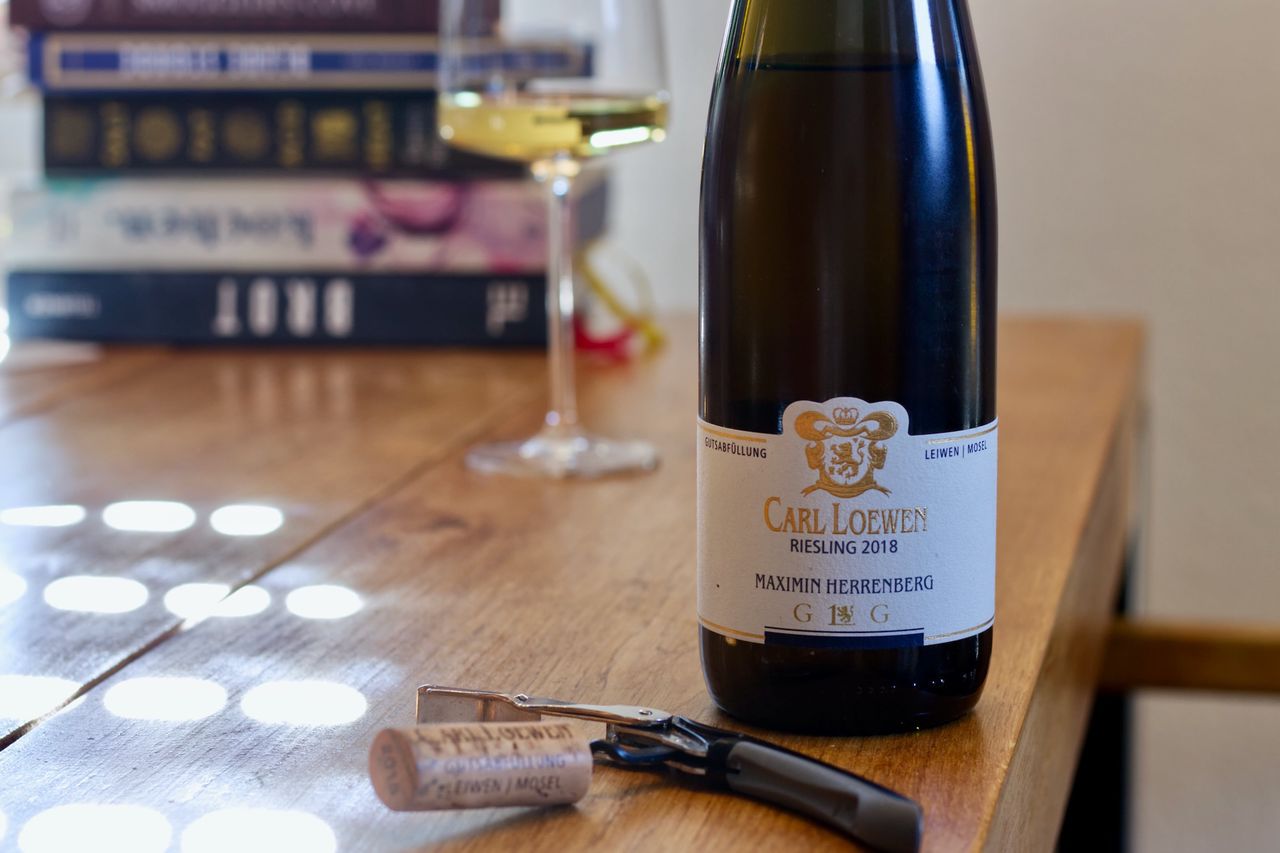Carl Loewen - Maximin Herrenberg 2018
We are drinking a bottle of Maximin Herrenberg GG from Weingut Carl Loewen from the Mosel.

Whether I would have placed Longuich geographically on the Mosel without looking it up, I’m not sure. That’s simply because all of my on-the-ground knowledge comes exclusively from Mythos Mosel, and the westernmost section of Mythos starts in Detzem. Longuich is another full bend of the river upstream toward Trier. And while heading downstream toward Koblenz at least triggers some “Terrassenmosel” synapses in my brain and I could place towns on the map, it’s a bit of a blank around Trier, at least until today. Quite apart from that, if I’d seen a bottle of wine with “Maximin” and “Herrenberg” in the name, without seeing the label, I would have placed it on the Ruwer anyway. And there are Herrenbergs in the German vineyard portfolio like sand on the beach. The Longuicher Maximin Herrenberg lies across from the village on the other side of the river, facing southwest. The red slate here doesn’t seem to appeal much to phylloxera, because there are still vines in the vineyard that were planted shortly after the turn of the last century, around 1902. The winery even has a wine from a parcel here that’s a few years older. But with vines over 100 years old, you can safely call them old vines in both cases.
The history of Weingut Carl Loewen goes back roughly another hundred years to the beginning of the 19th century. Leiwen, where the estate is located, I can place pretty well on my mental map, since I’ve been there before. Currently, Christopher and Karl Josef Loewen, son and father, are responsible for the wines. The estate is a member of the association Der Ring, which until 2024 was called Bernkasteler Ring, and bottles this wine as a Großes Gewächs according to the group’s statutes, which read quite similarly to the VDP’s rules. I haven’t compared them in detail. Just so much: grapes only from classified steep slopes, Riesling or Pinot, limited yields, and the wines must be dry to qualify as GG in the Ring.
The bottle of Maximin Herrenberg today is from the 2018 vintage. And with 2018, our experiences in recent months and even years have been rather mixed. The hot year really demanded a lot from vines and winemakers, and the wines often don’t mature particularly harmoniously. Broad and sprawling, already tired or unpleasantly bitter, we’ve had all of that, and unfortunately, more than once. So there’s always a bit of apprehension when pulling the cork on any 2018 bottle. Luckily, that’s not the case here.
There’s yellow fruit on the nose, some mineral spice, and also a hint of maturity. Not so much from crumbly fruit or butteriness, but the fruit has a tone you don’t find in young Riesling. There’s a bit of cassis spice in the background, not cassis itself, but the kind of structure blackcurrants have. With the first sip, I double-check the bottle. Yes, it actually says trocken which means dry and as mentioned, Ring GGs have to be dry. And yet the fruit comes across as really sweet. Pineapple juice, pome fruit, and a touch of Piña Colada. The acidity takes a few moments to get going. I couldn’t find any analytical data, but the term “Mosel dry” exists for a reason, and I think the wine has a few grams of residual sugar. Maybe I’m wrong and it really all comes from the fruit and matured extract. Since I’m not a fanatic for bone-dry wines, not even for GGs, it doesn’t bother me at all. On the contrary, I think it suits the wine brilliantly.
What’s impressive is how little the wine changes overnight. That’s also not my usual experience with this vintage. Many wines that seem fresh on the first night tend to collapse overnight. The Riesling’s aroma now has a slight liqueur note, a sign of some maturity, but the fruit is still beautiful, and so is the minerality. I like the fruit even more on the palate than on the nose. So much pineapple. This isn’t a wine that dances lightly over your tongue, there’s substance, power, and volume, it was a warm year, 2018. But it isn’t heavy or clumsy. After every sip, you want another, and then another. And if you start to think about what those truly old vines on the Mosel must have seen over the years, and how, after so many decades, they managed to produce grapes for such a wine in a warm year like 2018, well, all that’s left is humility.